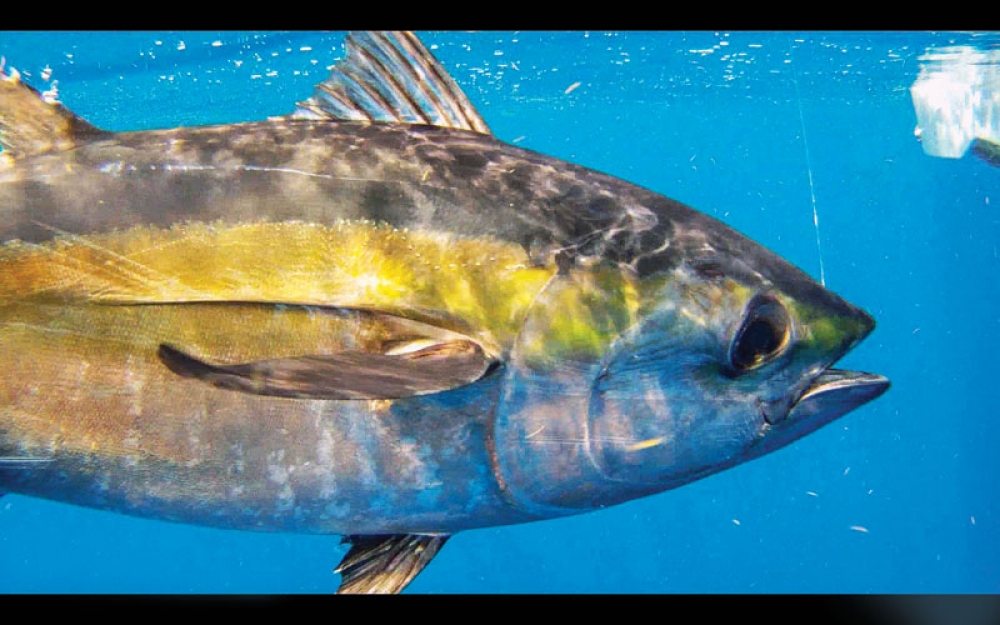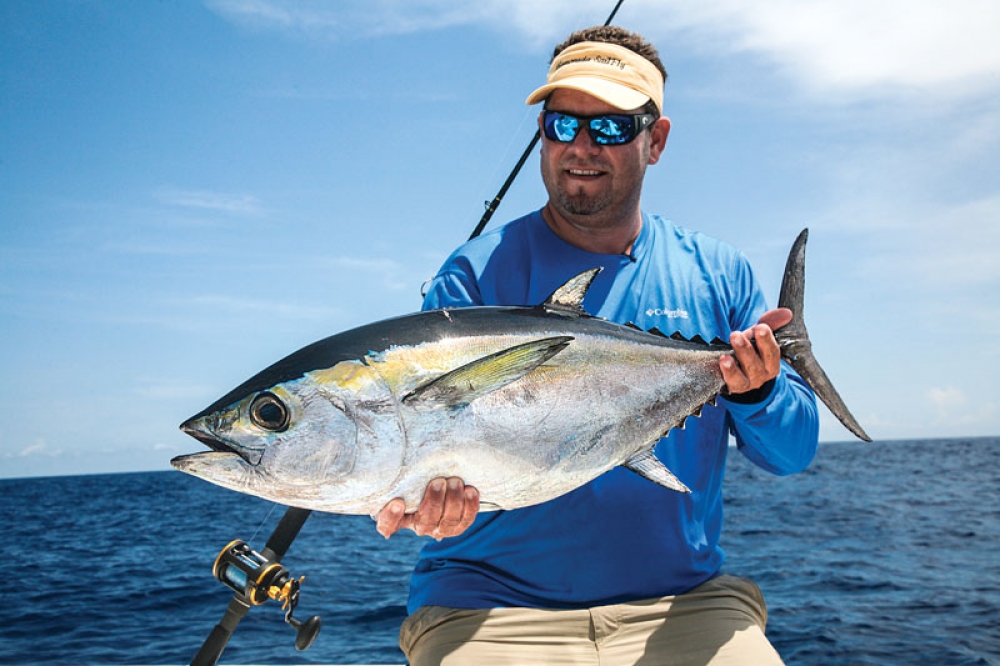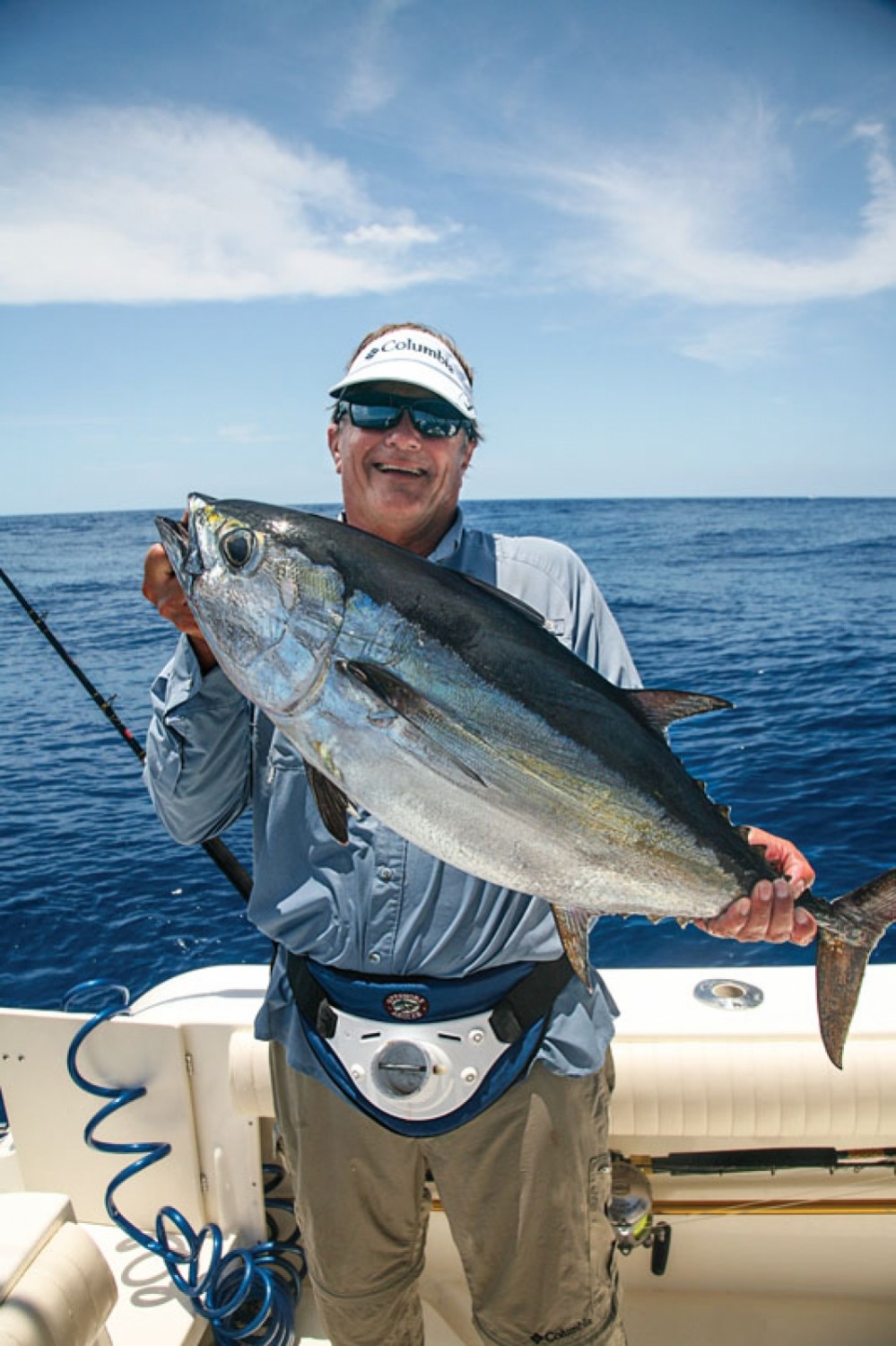By George Poveromo – from Saltwater Sportsman Magazine online November 17, 2014 – please click here for original article.
Above: Marathon Hump Blackfin Tuna – A bragging-size blackfin comes to the surface after a lengthy battle. Photo by George Poveromo.
Capt. Ariel Medero was cool, calm and confident as we drifted for trophy- class blackfin tuna over the Marathon Hump with two gunwale-based rods. The scene around us, however, wasn’t as serene: anglers live-chummed, flutter-jigged and even trolled for tunas averaging 5 to 10 pounds. But Medero knew something those aboard the busy dozen or so boats didn’t, and it was paying dividends for us.
As if on cue, Medero’s rod bent over as a boat trolled by. He lifted the rod from the gunwale and maintained pressure as the fish took off straight toward the bottom. It was likely another big blackfin. Earlier, we had boated fish weighing 26 and 27 pounds, and we had lost four others to frayed light-fluoro leaders. The fights had lasted an average of 20 minutes on our 20-pound-class conventional outfits, but Medero’s latest encounter easily surpassed that mark. Some 35 minutes after he hooked up, I finally sunk a gaff into a whopping 33-pounder.
Capt. Ariel Medero, who operates Big Game Sportfishing Charters out of Marathon in the Florida Keys, is typically in his 35-foot center console catching grouper and snapper on the reefs and wrecks, running and gunning for dolphin or daytime swordfishing. On this trip, however, he plied his other specialty — catching trophy blackfin tuna — aboard my MARC VI while we shot a TV show episode for 2015.
Go Deep
Blackfin tuna frequent the Marathon Hump year-round, with the larger fish showing up in the spring and returning in fall and winter. The majority of those encountered by anglers throughout the year are the 5- to 10-pounders, the ones under birds, blitzing forage at the surface. While those fish are certainly fun on light tackle and superb on the grill, most of the big tunas give anglers the slip.
Medero believes the largest blackfins stack up well beneath the smaller ones, where most baits seldom reach them, the reason why, on our trip, we positioned one bait down around 200 feet and a second one between 300 and 350 feet.
Popular Strategies
There are three common tactics for catching blackfins on the Florida Keys humps. Trolling small feathers and swimming plugs — such as Rapala
CD 14 — with 30-pound fluorocarbon leader is a favorite of those who can’t procure enough live pilchards for chum. When pulling a pair of swimming plugs, incidentally, position them roughly 100 and 150 yards back and bring your speed to around 10 mph. Towing the lures far back and fast catches more fish. Flutter jigs also put fish in the box. First, mark the tuna on the fish finder; then lower the irons. Again, 30-pound fluorocarbon leader is best, as is rapid and radical jigging. The third approach, more effective for targeting larger blackfins, is broadcasting dozens of live pilchards behind the boat, along with a couple of hooked baits. When the positioning and timing of the baitfish dispersal are right, the tuna rise in a frenzy.
Above: Marathon Hump Blackfin Tuna – Capt. Ariel Medero with a blackfin tuna caught near the Marathon Hump. Photo by George Poveromo.
Easy Does It
Medero prefers a different technique: Rather than attempting to chum the larger fish to the surface, he likes to bait big blackfins deep, where they spend most of their time. It’s easy fishing. You get by with a dozen or so live baits in just about any flavor or combination: pilchards, small blue runners, herring, sardines and even the lowly pinfish, which the 33-pounder ate. It’s also relaxing. You fish with two rods set in the gunwale holders for the drift across the Hump. When a rod bends, you wind tight to the fish, then pick up the rod and enjoy the fight
We used level-wind star drag reels filled with 20-pound monofilament. Given the current and the power of a big blackfin, short fights are rare. Most of our 20-pound-class fish took nearly half an hour to boat. It’s fun and challenging, yet the lengthy fights could prove costly when sharks abound.
Terminal Debate
Medero adds a 40-foot, 40-pound fluorocarbon top shot to the 20-pound fishing line with a Bristol knot. At the business end of the top shot he adds a small barrel swivel (to alleviate line twist), then a few feet of 30-pound fluorocarbon and either a 2/0 or 3/0 live-bait style J hook. When deploying the bait he adds weight with a snap swivel. A 6-inch length of 20-pound mono is used to attach an egg sinker to the snap swivel, which is then hung from one leg of the Bimini twist, up where the double line joins the top shot. The snap remains open, incidentally, for quick sinker removal when a fish comes boat-side. On this particular day, we used a 10-ounce weight.
As mentioned earlier, we had lost four large blackfins that frayed through the leader, so I questioned the logic of using live-bait style hooks instead of in-line circle hooks. The tuna are likely to swallow a small J hook, exposing the leader to the chaffing effect of their teeth. Meanwhile, the eye of a circle hook — if properly set — remains outside of the fish’s mouth, with no threat of chafing.
Medero believes small, light hooks are a must to fool big blackfins, and his record of outstanding catches speaks for itself. Still, I prefer circle hooks and the peace of mind they offer when I step up the pressure on a fish and I’m using a light leader. As for Medero’s 33-pounder, it was hooked perfectly in the upper jaw, with the eye of the hook visible outside the tuna’s mouth. Lady Luck smiled on him once again.
Right Moves
We repeatedly ran up-current of the Hump, far enough to deploy two baits, before shifting into neutral and drifting to a quarter mile down-current of the seamount. Medero positioned his bait around 200 feet down, and I placed mine some 100 to 150 deeper. Each bait was hooked through both jaws to keep it swimming with the drift. Our reels were in gear at the fighting drag setting as we watched the rod tips. By the way, it’s not when the rod bends that you want to reach for it, but rather when the rod straightens, which indicates a fish swimming upward with the bait.
I activated the trail feature on my plotter to record and monitor our drifts. If we caught a fish during a pass, we repeated the same drift. If we went strike-less, we repositioned ourselves to drift across another section of the Hump. At day’s end, we had thoroughly covered every bit of it.
When blackfin fever takes hold, head to the Marathon Hump, set a pair of live baits deep, then sit back, relax and enjoy your drift across the underwater mountain. Chances are you’ll be interrupted by bragging-size blackfin tuna on more than one occasion.
Above: Blackfin Tuna Fishing in the Florida Keys. – The author is all smiles, hoisting a sizable tuna caught over the Marathon Hump. Photo courtesy George Poveromo.








